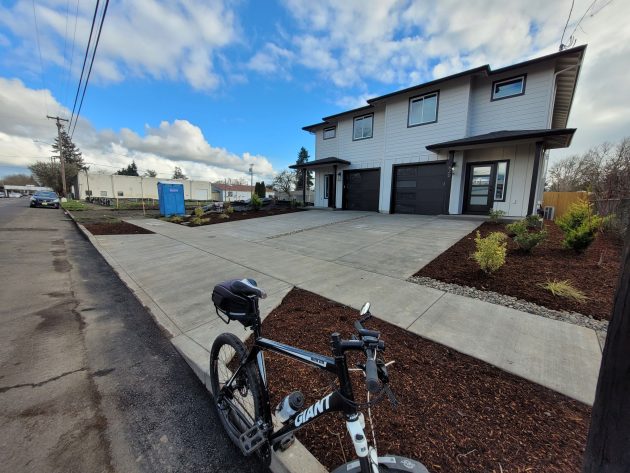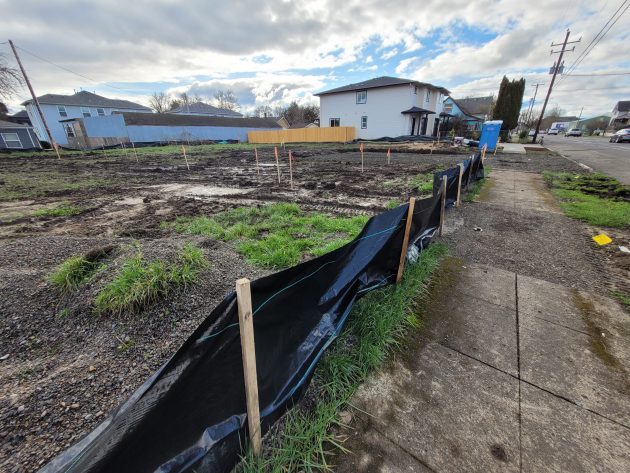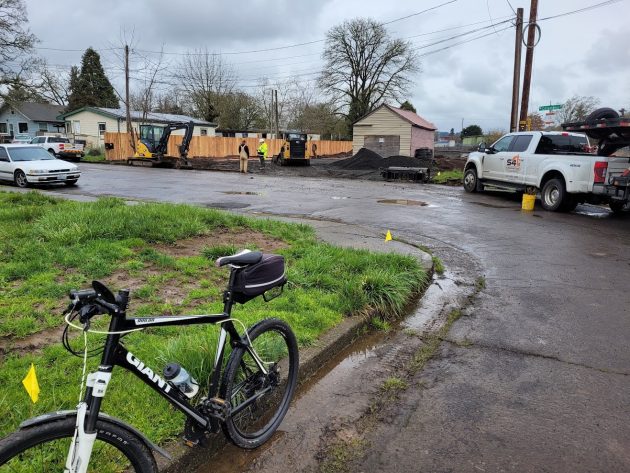
In the 600 block of East First Avenue, a new duplex sits on a previously vacant lot.
In Oregon’s quest for more affordable housing, building on vacant or underused land inside cities makes far more sense that expanding urban growth boundaries to gobble up farmland.
I pointed this out when I stopped on a bike ride Friday. Here’s the video:
In Salem, Gov. Tina Kotek is asking the legislature to pass her $500 million program to encourage more housing construction. The worst part of her plan is the proposal for a shortcut procedure to allow cities to expand their growth boundaries.
In Albany we have seen the results of annexations of grass fields on the outskirts of town. On the east side of I-5 and south of town, we now have hundreds of acres of sprawling subdivisions of single-family houses, and more are being built.
Most of those houses are priced around $500,000. They are far from stores and offices, meaning more car traffic and pollution.
All those new streets, smooth and beautiful now, will start falling apart in 30 years, and there’s no mechanism for the city or neighborhoods to set aside money to repair the streets when the time comes.
Some land owners and developers in Albany are doing something smarter. They build housing on existing streets and utility systems within the city.
I’ve seen lots of examples of this in recent years, including several duplexes that sprang up on vacant lots within existing housing tracts.
Just now, a builder finished a nice duplex in the 600 block of East First Avenue. And next door, near Thurston Street, construction is starting on an apartment house.
At the east end of First, on the corner of Columbus Street, contractor Jerid Strasheim has finished demolishing a derelict old house. On Friday he and his crew (his company is S4Excavation) were preparing the lot for the placement of a manufactured home.
It’s an example, just one of many in the established parts of Albany, of how to create housing without building more streets or destroying more farms. (hh)

Next to the new duplex on East First, vacant land is being prepared for an apartment building.

The lot in the background, at Columbus and First, has been cleared for placement of a manufactured house.


Same at Water and Hill Streets, directly across Hill St. from the Calapooia Pub. Dahl Construction has cleared the former warehouse to make way for what I am told is 3 story apartment complex. Assume you can find the exact plans either from Dahl or the City Planning Department. I couldn’t live there myself without creating a “proximity problem.”
I drive by that duplex every day on my way home so I’ve seen it develop from tearing down the old structure to constructing this new duplex. Also the big apartment building further on 1st St near Lyon St bridge. The newer apartments on Water Ave, etc in the downtown area. I think it’s great to have new housing to start making downtown Albany a newer, prettier, safer looking area to be! I hope to see more!
As long as the cities give contractors the go-ahead to put subdivisions on farmland, the contractors will do it.
Alot of old building need taken down,and new places be built no reason to go to outskirts of Albany would be nice if section 8 would build senior living,in some of these lots.
I agree that it makes sense to utilize infill lots where infrastructure is available. It also makes sense for cities to expand their urban growth boundaries in areas that are not prime areas for agriculture. Many hillside areas with poor soils are suitable for housing but not agriculture.
When cities decide to expand housing within the city they begin to neglect the streets and infrastructure of the areas where they want to rebuild. Home owners are pressured to leave these areas to allow for new construction. Homeownership is decreasing in Oregon and homelessness is increasing. Affordable housing is not available to the newly homeless people. Home retention is a major deterrent to homelessness. Over populating these areas is not. Protecting farmland is important as is the still viable homes in the city. Albany needs to focus on the sustainability of the residents already living here.
“In Albany we have seen the results of annexations of grass fields on the outskirts of town. On the east side of I-5 and south of town, we now have hundreds of acres of sprawling subdivisions of single-family houses, and more are being built.”
Those annexations have been within the UGB (Urban Growth Boundary). That’s what it was designed for -years ago…. It has nothing whatsoever to do with creating a ‘shortcut procedure’ to expand them.”
Ray, I’m sure you’re correct. The former farm lands to the east and south were already within the UGB when they were annexed and developed. So perhaps that was not the best example to use in this discussion. But Hasso’s point, which I agree with 100%, is that there is no need to expand Albany’s UGB (or for an expedited process for expanding UGBs, as the legislation is proposing) because Albany already has lands within the city limits that can be repurposed or renovated to provide additional housing. As Hasso has shown here, and with many other examples in his previous posts, Albany is choosing the smart path in developing vacant and underused lands within the city, rather than encouraging development to sprawl outside the UGB.
Huh? Are they …the city of albany… being smart? My often usual daily walk I can count 2 maybe 3 In Fill lots. build it out?
Why let land horders delay?